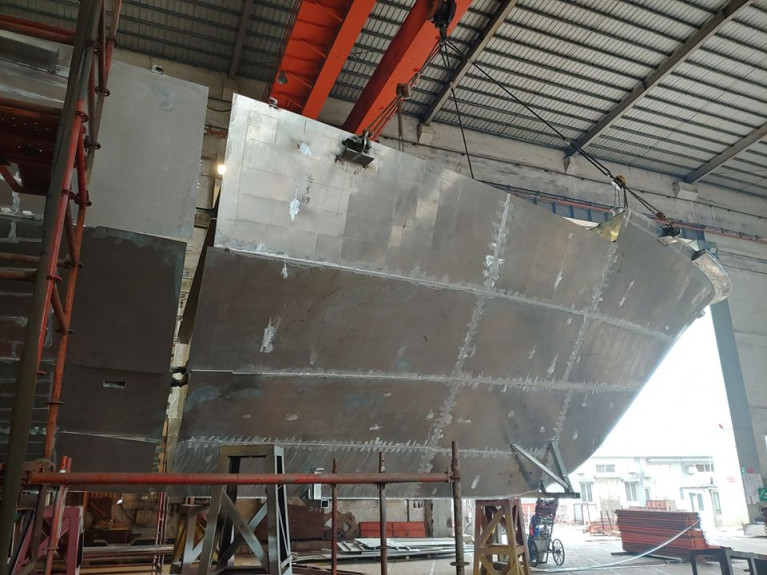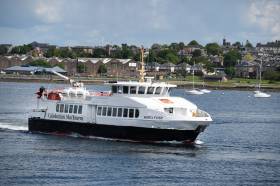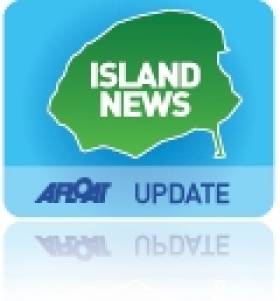Displaying items by tag: Aran Island Ferries
Galway-Aran Islands Ferry Operator Attends Tourism Ireland Promotion to Belgian & Dutch Travel Agents
The focus was on Galway, as the west coast city’s attractions and region were promoted to 50 overseas tourism operators from Belgium and neighbouring Netherlands.
Galway was also been promoted to travel agents at Tourism Ireland’s B2B workshops events held in the Belgium capital of Brussels and Amersfoort, a city south-east of Amsterdam.
Among those attending the workshops Galway FM reports, with one to one meetings with the travel trade on 12th September included Aran Island Ferries and Killary Fjord Boat Tours.
With its direct ferry service to the Aran Islands and also out of Rossaveel, Aran Island Ferries represented their five-fleet operations and tourism product to the travel trade. Another Co. Galway based excursion operator, Killary Fjord Boat Tours which runs along the boundary with Co. Mayo was present at the Tourism Ireland event where around 35 outlets of the Dutch media were invited.
Both operators were signing contracts for the season of 2024 and beyond, so the events held in both nations provided a key time to influence the addition of new tourism products to their programmes.
Other tourism businesses and operators from the island of Ireland, Afloat adds included Irish Ferries which operates the UK landbridge to mainland Europe via Dover-Calais, with the French port close to Belgium. In addition to their direct Cherbourg connection to Dublin.
The Easter holiday saw the resumption of the seasonal Galway-Aran Islands fast-ferry route with domestic passengers and tourists alike using the direct service, writes Jehan Ashmore.
In preparation to the opening of the season on Good Friday, Saoirse na Farraige, Aran Island Ferries flagship fast-ferry had the previous day carried out a repositioning run. This involved a coastal passage from Rossaveel in Connemara to Galway.
As the most modern and largest ferry in the operator's fleet, Saoirse na Farraige with an almost 400 passenger capacity serves on Ireland's longest distance coastal ferry route of Galway-Kilronan (Inish Mor). The route from the mid-west city takes 1 hour 30 minutes (90 minutes).
In addition Aran Island Ferries operate year-round routes between Rossaveel in Connemara to all three Aran Islands.
As for the Galway-route, Saoire na Farraige as part of its schedule also operates an award-winning Aran Islands and Cliffs of Moher cruise. The scenic views which form part of the Wild Atlantic Way take on a whole new perspective when observed from the sea.
To provide these services is where operator, Aran Island Ferries had the custom-built 40 metre monohull Saoirse na Farraige built in Hong Kong. The 454 gross tonnage passenger ferry was delivered from the Asian shipyard on board a heavy-lift ship the Svenja which arrived to Galway Bay in 2020.
The Saoirse na Farraige entered service the following year and is the largest ferry operating in Irish coastal waters having revived the direct link with the city after an absence of many years. With this service islanders benefit by having more time in Galway before taking the ferry back the same day in addition to offering tourists a day trip excursion.
As alluded the routes from Rossaveel to the three Aran Islands (of Inis Mór, Inis Meáin and Inis Oírr) are maintained year round with the Rossaveel-Inis Mór been the busiest and taking 40 minutes.
On these Connemara-Aran Islands routes, they are operated by four fast-ferries that are secondhand tonnage and custom-built.
Rossaveel Harbour is located 37km (23 miles) west of Galway city. From the city-centre, foot-based passengers use the ferry operators shuttle bus service to connect to and from the harbour with sailings linking to the island archipelago.
A group of 40 Ukrainians who have fled conflict visited the Aran island of Inis Mór on Wednesday as guests of Aran Island Ferries.
The group boarded the vessel Saoirse na Farraige in Galway docks, where they were welcomed by skipper Aodhán MacDonnacha.
The group, who are with the Ard Resource Centre, were taken to Inis Mór, where they visited archaeological sites including Dún Aenghusa.
They were met by Gabriel Faherty of Aran Food Tours and Aran Goat’s Cheese, and had lunch at Tigh Nan Phaidí. On the return trip, the ferry cruised close to the Cliffs of Moher.
The visit was co-ordinated by Aran Island Ferries and the Galway and Roscommon Education and Training Board.
Ferry operator Aran Island Ferries has announced it’s on track to make history this summer – by commissioning Ireland’s largest domestic ferry.
The boat, reports GalwayBayFM, will be a 40 metre vessel with space for 400 passengers, which represents a significant boost in capacity over it’s current largest boats, Music of the Sea and Magic of the Sea.
The new vessel will be the sixth boat in the Aran Island Ferries fleet – though full details or a name for the vessel have yet to be revealed.
Afloat.ie adds as for the names of the larger ferries this is in fact their English translation. The names of these vessels are in Irish, Ceol na Farraige (built 2001) and Draíocht na Farraige (1999) respectively.
Each of the 37m Wavemaster monohull craft can carry 294 passengers.
A former Aran Islands passenger-only ferry, Argyll Flyer has returned with a new corporate livery following annual dry docking in Scotland to the Gourock-Dunoon route on the Clyde.
Afloat adds the former Queen of Aran II was custom built for Inis Mor Ferries (no longer in existance) and later sold to Aran Island Ferries. The 227 passenger ferry has recently been rebranded as a Caledonian MacBrayne vessel.
According to CalMac the new look sees the iconic black and red livery and follows as Afloat previously reported Argyll Ferries incorporation into the operator's Clyde and Hebrides Ferry Service contract.
As well as a repaint during refit, CalMac say the vessel has had all new upper deck seating installed, new thermal insulation fitted in the passenger saloon, as well as an overhaul to the engine, gearbox, steering, electrics and propellers.
Launched in 2001 at OCEA shipyard at Les Sables-d'Olonne in France, the 178 tonne Queen of Aran II served between the Aran Islands and Rossaveal, Co. Galway and subsequently with Aran Island Ferries before transferring to Argyll Ferries in 2011.
CalMac Ferries managing director, Robbie Drummond said: 'I'm delighted to welcome MV Argyll Flyer back into service in her new livery ready for another busy year. Incorporating this service into the CalMac family will allow us to concentrate efforts on developing service improvements over time to help drive more traffic in support of the Dunoon economy.'
Transport Scotland have indicated improved harbour facilities for passengers will be considered on the route in the future, including the possible introduction of electric vehicle and electric bike hubs at both ferry terminals, as well as developing the ferry service to encourage active travel users.
The other vessel serving the route, MV Alicat, will be rebranded when will undergoe an annual dry dock service later in the year.
Afloat adds that a current Aran Island serving ferry, Glor Na Farraige also operated by Aran Island Ferries went for a refit in Co. Donegal at Mooney Boats boatyard in Killybegs. The work which took place in recent weeks involved shot blasting and painting of the 255 passenger ferry.
Likewise of Arygll Flyer, this ferry was also built in France when launched in 1985 as a 37m metre Wavemaster monohull vessel.
Ferry Runs Aground off Doolin for Three Hours
According to ferry operator Kevin O'Brien, there were no passengers on board at the time and the vessel got under way again when it was lifted from the rocks with the tide. Mr O'Brien added "this was a very minor incident and there was no damage to the ferry. Doolin is tidal so these things do happen. Even a few inches of water can make a difference".
The Irish Coast Guard was notified of the incident at midday, and its marine rescue co-ordination centre in Dublin requested that members of the local Coast Guard unit board the vessel to assess if there was a pollution risk.
Doolin Coast Guard personnel carried out an inspection and confirmed the ferry had not been damaged and there was no risk of pollution. At about 2.15pm the ferry got under way again with the tide. The company was able to operate services to and from the Aran Islands with its second vessel.
Auction of Aran Islands Passenger Ferry Sisters
Aran Direct (which was the trading name for Bád Arann Teoranta) operated on routes between Rossaveal to Inis Mór, Inis Meáin and Inis Oírr. The company competed in an intensely competitive market with at least 10 other vessels combined from the fleets of Aran Doolin Ferries, Aran Island Ferries and the Doolin Ferry Company.
In September 2008, Aran Direct ceased operations and the vessels were laid-up at Rossaveal, where they remain, as seen (if not previously sold) prior to the public auction.
At the instructions of Liam Dowdall Esq., Receiver & Manager, Bád Arann Teoranta (in receivership), the vessels are to be sold in one or separate lots. The public auction is to be held at 12 noon on Thursday 24th February at the Harbour Hotel, The Docks, Galway.
An outline of the vessels details can be downloaded in PDF format by clicking HERE. For further details, photographs and conditions of sale contact Dominic J. Daly, Auctioneer, Cork Tel: (021) 4277399 or E-mail: [email protected] and logging on to www.dominicjdaly.com
For further technical details, you can contact Noel O'Regan of Promara Ltd on 087 3435666 or email [email protected]
































































